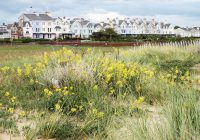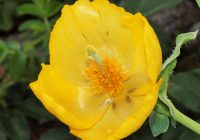Dr Phil Smith’s Wildlife Notes
June 2015
A desperately dry month spelt disaster for the few sand-dune wetlands still holding enough surface water to support Natterjack tadpoles and contributed to several large fires in the dunes. On 9th, Patricia Lockwood and I netted and relocated about 2000 tadpoles on the southern section of Birkdale Green Beach to 12cm depth of water. However, lack of rain meant the site had dried up by 22nd. Indeed, it seems likely that there will be a complete breeding failure this year.
The legacy of a cold spring resulted in most plants and insects being about two weeks later than usual but, despite the drought, our duneland orchids put on a spectacular show. Although we must have missed lots, my friends and I counted an astonishing 1390 Bee Orchids in an area of frontal dunes measuring about 200 x 30m north of Shore Road, Ainsdale. Here were also plenty of shocking-pink Pyramidal Orchids, as well as Southern and Early marsh-orchids in the damper hollows. Orchids are notoriously promiscuous and we found some particularly fine plants of Southern Marsh-orchid x Common Spotted-orchidhybrids, these dramatic spikes being appropriately named Dactylorhiza × grandis.
Orchids also featured at Haskayne Cutting Nature Reserve. Here carefully timed mowing over several years has resulted in a steady increase in numbers, culminating this month in nearly 900 Northern Marsh-orchids, 65 Early Marsh-orchids and ten Bee Orchids. Some of the northerns may be hybrids with the rather similar Southern Marsh-orchid but determination of these requires an expert, so I may have to send photographs to Prof. Bateman at Kew.
Patricia Lockwood and I completed the major survey I mentioned last month of the Isle of Man Cabbage, updating information last obtained in 2012/13. The news is good, with an overall increase of 21% in the numbers of plants at four localities. It was especially pleasing to find 22 individuals at Southport Marine Lake dunes, as we thought it was extinct here. Another boost was 211 plants on the shore dunes at Crosby, confirming the success of a rescue operation that had introduced transplants to this ridge during the 2011 coast-protection scheme.
Following up a report by Pete Kinsella, we visited Hightown on 24th to look for Yellow Horned-poppy on the artificial shingle beach. Sure enough, 16 specimens were counted, many of them in flower. None was seen last year and we were worried that the big storm surges in the 2013/14 winter had wiped it out. Another shingle specialist, the Sea-kale, is down to one individual but, encouragingly, we found several plants of Rock Samphire. Nearby, several pink and white-striped flowers of the rare Sea Bindweed at one of its old-established colonies and three Broad-bodied Chasers at two excavated scrapes added to an entertaining afternoon.
It’s always enjoyable to share the riches of our coast with like-minded enthusiasts but not often do we have visitors from France. Eighteen members of the Nantes Botanical Society joined me on 27th for a guided walk from Ainsdale-on-Sea northwards to the Green Beach. Amongst a wealth of flowering plants, they were delighted to see such northern and western specialities as Variegated Horsetail, Slender Spike-rush and Baltic Rush, the latter at its only English location. The orchids were popular, of course, but equally impressive were great drifts of golden Kidney Vetch dominating the landscape.
Another big event was the National Trust’s “Bioblitz” on 20th. Again, there was a big turn-out for a botanical foray at Formby Point, the highlights including Pyramidal Orchids, Changing Forget-me-not, Common Wintergreen (a Sefton Coast rarity) and the always hard to find Smooth Cat’s-ear.
The month ended with a brief heat-wave and a visit to a friend’s large garden pond at Hillside. The benefits to wildlife of these features are well-established, especially if they are not stocked with fish, which tend to eat everything. While enjoying a much needed cool drink, I recorded six species of dragonfly and damselfly, a big surprise being a male Banded Demoiselle. This is a running-water species whose nearest population is on Downholland Book about 3 miles away. However, one had also been reported the previous day at a Birkdale scrape, so the high temperatures must have got them moving.



